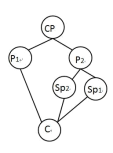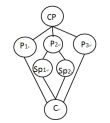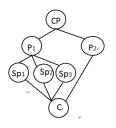1 . Benefits of Cross-Country Skiing
Cross-country skiing can be enjoyed by a wide range of students, from the youngest kindergartners to those secondary students. It is really a fun activity, providing students a gentle workout outside in winter. While having fun, students can gain physical and mental benefits .
The physical benefits of cross-country skiing are well known. If we look at Olympic cross- country skiers, we can see the positive effects on the body that result from training for cross-country skiing. The average best female cross-country skier carries 11 percent body fat, and best male skiers carry 5 percent. These percentages are well below the average for people who are considered to be athletic-17 percent for females and 10 percent for males. The high number of calories burned while skiing helps to keep skiers slim in a healthy and attractive way.
Cross-country skiing is also an efficient way to exercise a large number of muscles at once. Because skiers use ski poles as a means of propulsion, the force that drives skiers forward, the upper body gets much more of workout. Of course, the leg muscles also do their fair share. People who use cross-country skiing as a workout over several weeks will discover that the muscles of their entire body increase in strength.
Cross-country skiing on a regular basis has a tremendous effect on a person’s cardiovascular system. In addition to gaining strength in the muscles of the upper and lower body, people who use cross-country skiing as a workout method over several weeks will also discover that their heart is stronger. A strong heart pumps more efficiently, sending out more blood to the muscles with each contraction. Through weeks of skiing, people often discover that their resting heart rate has decreased. Highly trained Olympic cross-country skiers have resting heart rates between 28 and 40 beats per minute. Compare that to the resting heart rate of the average person, which is 60 to 80 beats per minute!
The benefits of cross-country skiing extend beyond overall general health. A lot of evidence exists indicating that regular physical activity increases the release of mood-lifting endorphins in the body. After one of the energetic and fun skiing lessons, students will be smiling and laughing; they will be relaxed and in a better mood than when they started class. Students will leave class with a sense of accomplishment, knowing that they have developed new skills in a fun activity.
Cross-country skiing is a great way to work the total body. Now more and more students are taking part in this exercise outside during the winter months. They are enjoying it and benefiting from it!
1. The underlined word “workout” means ______.| A.manner | B.exercise | C.application | D.opportunity |
| A.requires the use of most muscle groups | B.offers students a unique way to keep fit |
| C.can increase the athletes’ resting heart rates | D.can balance out the skiers’ increased calories |
| A.By making comments. | B.By giving examples. |
| C.By making comparisons. | D.By giving explanations. |
CP: Central point P: Point Sp: Sub-point (次要点) C: Conclusion
A. | B. |
C. | D. |
2 . Worth the pain in the end
I used to hate running. It seemed too hard and pushing outside my comfort zone was not something I was raised to do.
In fact, I wouldn’t have become a
“So start running again, why don’t you?” I was getting
So he picked it up again, and after about a year, I started to join him at the track (跑道). Just a few weeks later, Charles signed us both up for a five-kilometer race. I
But on
The gun went
The first kilometer was
“I don’t think I’m going to make it.” I was already breathing heavily and painfully aware of the group of runners pounding past me.
“No, you’re doing
“I can’t,” I said, barely audibly (听得见地).
He tried a different way to
After another minute I saw the three-kilometer
Miserable doesn’t even begin to describe
“You’ll be fine. You’ve got less than a kilometer to go.”
I rounded a corner and saw both sides of the street thick with people watching the race, all cheering the runners on. I willed my legs to keep going.
Then I looked up and saw the clock. The seconds ticking away (一分一秒地过去) gave me an incentive (助力). I knew that if I finished this race, I would have achieved something. So, I straightened up, and kicked it.
I had my arms held higher when I passed
“You did great! I’m so proud of you!” Charles was thrilled that I’d
“That was AMAZING! I want to do another race. This running stuff is amazing!” I proudly hugged my medal as we started to walk to the post-race festivities.
My lungs and my comfort zone both
| A.runner | B.traveler | C.racer | D.cheerleader |
| A.afraid | B.tired | C.aware | D.confident |
| A.thought | B.dreamed | C.hesitated | D.cared |
| A.race | B.sport | C.show | D.task |
| A.on | B.off | C.up | D.down |
| A.long | B.short | C.easy | D.tough |
| A.wrong | B.right | C.great | D.bad |
| A.disability | B.dishonor | C.disgrace | D.discomfort |
| A.advise | B.persuade | C.urge | D.force |
| A.signal | B.symbol | C.point | D.mark |
| A.how | B.what | C.when | D.why |
| A.by | B.over | C.across | D.through |
| A.ring | B.necklace | C.medal | D.scarf |
| A.done | B.made | C.taken | D.caught |
| A.developed | B.expanded | C.changed | D.progressed |



